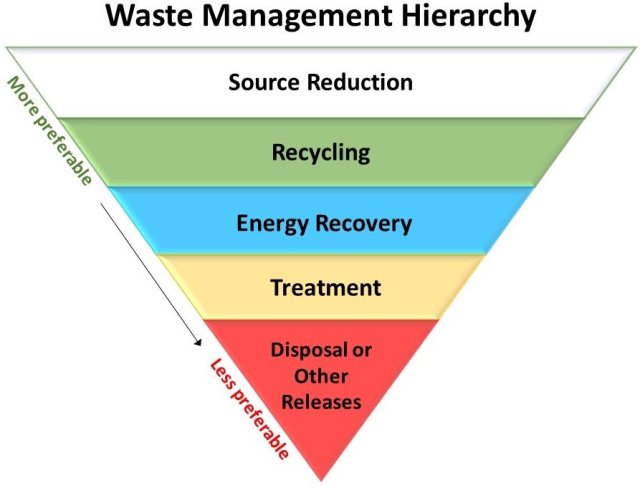TRI in the Classroom: Understanding Chemical Waste Management
When the chemicals used to make everyday products like clothes, tires, and electronics are not useful anymore, those chemicals become waste. The facilities that make the products decide what to do with the chemical waste. They report this information to EPA’s Toxics Release Inventory (TRI), and anyone can look it up online.
What Can Facilities Do with the Chemical Waste They Create?
| Recycling | Energy Recovery | Treatment | Disposal or Other Releases |
|---|---|---|---|
| Some or all of the chemicals in the waste can be removed and used again. | The chemical waste can be burned in a furnace or boiler to produce energy. | The waste can be put into special equipment to be destroyed or changed into chemicals that are less harmful. | The waste that is left after facilities use the first three methods can be released into the environment or disposed of. See TRI in the Classroom: Understanding Releases for details. |
Preferred Waste Management Methods

When the options for managing waste are listed in order from EPA’s most to least-preferred option, as shown in the image to the right, it is called the Waste Management Hierarchy.
The preferred methods for managing waste are recycling, energy recovery and treatment. When these are not possible, a facility may release its waste into the environment or dispose of it.
How a facility manages its chemical waste depends on many factors, including:
- Size of a facility: Smaller facilities may not have the equipment needed for some waste management methods.
- Amount of waste: Facilities may use different waste management methods if they create a lot of waste or only a small amount.
- Type of chemicals: It may not be possible or practical to use a certain waste management method on a chemical. For example, some chemicals don't produce much energy when burned, so a facility would choose another method. Some chemicals may be too valuable to dispose of, so a facility might choose to recycle the chemicals to get more use out of them.
If a facility manages its own chemical waste, it is called “on-site waste management.” If the facility sends its waste to another location to be managed, it’s called “off-site waste management.”
Reporting On-Site Waste Management
Facilities report to the TRI how much of each chemical is in the waste they make and how they manage it.
| Recycling | Energy Recovery | Treatment |
|---|---|---|
Facilities report the total amount of each chemical recycled during the year. This total might include the same material more than once if it is recycled multiple times. Facilities also report how they recovered the chemicals from the waste for recycling. There are lots of ways to do this such as by using machines or even other chemicals. Facilities that recycle chemical wastes usually reuse the chemicals themselves or sell them to other companies. They might be used for the same purpose or for a new one. | Facilities report the total amount of each chemical they burned for energy recovery during the year. They must report what type of machines they used to recover the energy. There are several different types of combustion devices they can use. Energy recovered from burning chemicals is typically used at the facility or a nearby facility. It can also be sold to the power company. | Facilities report the total amount of each chemical removed from the waste through treatment during the year. They must report what type of treatment method they used. Treating chemical waste will sometimes only destroy a portion of the chemical, so facilities report an estimate based on the type of treatment. |
Reporting Off-Site Transfers and Waste Management
Facilities also report to the TRI how much chemical waste it sends to other facilities and what they expect to happen to it there. For each off-site location, facilities report the quantity of the chemical that left the facility to be recycled, treated, burned for energy recovery, or disposed of.
Management Through Releases and Prevention
The least preferred option for managing waste is releasing it into the environment. Examples including sending chemical waste through a pipe into a waterway or through a chimney into the air. To learn more about releases, refer to TRI in the Classroom: Understanding Releases.
Facilities can use source reduction methods to reduce the amount of waste they create or release into the environment. To learn more, refer to TRI in the Classroom: Understanding Pollution Prevention.
